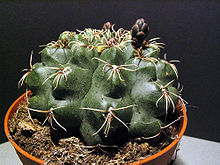Gymnocalycium baldianum
| Gymnocalycium baldianum | |
|---|---|

| |
| Scientific classification | |
| Kingdom: | Plantae |
| Clade: | Tracheophytes |
| Clade: | Angiosperms |
| Clade: | Eudicots |
| Order: | Caryophyllales |
| Family: | Cactaceae |
| Subfamily: | Cactoideae |
| Genus: | Gymnocalycium |
| Species: | G. baldianum
|
| Binomial name | |
| Gymnocalycium baldianum Speg., 1905
| |
| Synonyms | |
| |
Gymnocalycium baldianum, the spider-cactus or dwarf chin cactus, is a species of flowering plant in the cactus family Cactaceae, native to the Catamarca Province in Argentina.
Description[]
It is a globose cactus, spherical or a little flat, with a diameter up to 8 cm, dark green in colour, or sometimes brown. It has 8 to 10 ribs with tubercle-shaped areoles, covered in groups of 6 to 8 pale grey, curved spines, giving to the species its common name of spider-cactus. Like many cacti, it does not divide but may form offsets after some years. The funnel-shaped flowers reach a diameter of 6 cm, growing near the apex of the plant and are red, pink or orange.[2]
Cultivation[]
Gymnocalycium baldianum is easy to grow. It needs a well-drained soil. In summer, water the plants well, but let them to dry before watering again. Use monthly a fertilizer for cacti.[2] In winter, keep it dry, and the temperature may be as low as −10 °C (14 °F), but it is better to keep it without frost. The exposure must be sunny in summer and at least brightly lit in winter.
This species has gained the Royal Horticultural Society’s Award of Garden Merit.[3][4]
Gallery[]
|
References[]
| Wikimedia Commons has media related to Gymnocalycium baldianum. |
| Wikispecies has information related to Gymnocalycium baldianum. |
- ^ Perea, M.; Trevisson, M. (2017). "Gymnocalycium baldianum". IUCN Red List of Threatened Species. 2017: e.T152213A121526773. doi:10.2305/IUCN.UK.2017-3.RLTS.T152213A121526773.en. Retrieved 13 November 2021.
- ^ a b "'Gymnocalycium baldianum". Cactus Art Nursery. Retrieved 3 March 2018.
- ^ "RHS Plantfinder - Gymnocalycium baldianum". Retrieved 3 March 2018.
- ^ "AGM Plants - Ornamental" (PDF). Royal Horticultural Society. July 2017. p. 43. Retrieved 2 March 2018.
- IUCN Red List least concern species
- Gymnocalycium
- Cacti of South America
- Endemic flora of Argentina
- Garden plants of South America
- Least concern plants
- Least concern biota of South America
- Plants described in 1905
- Taxa named by Carlo Luigi Spegazzini
- Cactus stubs




